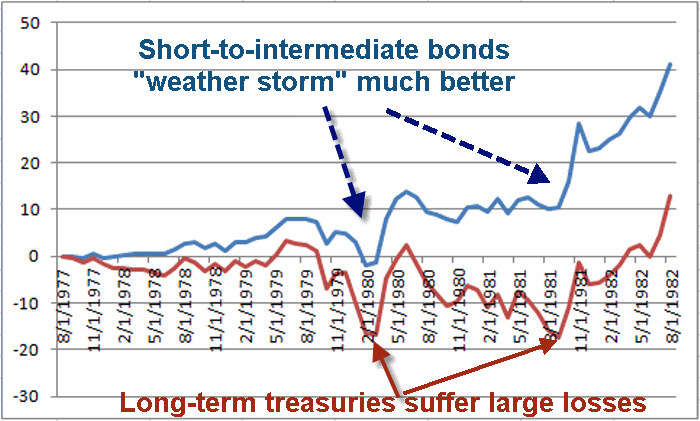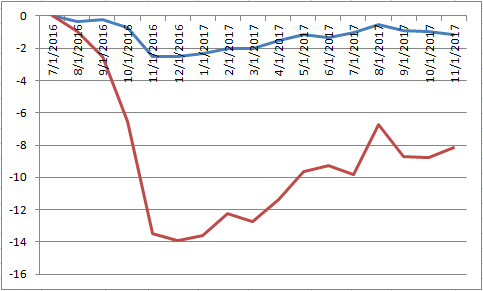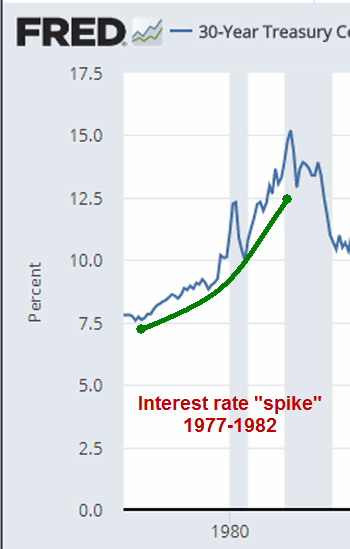OK, the truth is that I prefer to write about stuff that is at least “potentially” exciting, i.e., things that perhaps have a chance to accumulate well above average profits. But “boring” (and “consistent”) isn’t so bad for a lot of investors in a lot circumstances.
A 10-Month a Year Bond Index (Plus 2)
This “index” was developed by Dr. Jerry Minton, the President of Alpha Investment Management, Inc. It works like this:
*30% in short-term (1-3 yr.) treasuries
*40% in intermediate-term (3-7 yr.) treasuries
*30% in high-grade corporate bonds
10 Months: The original “index” of bonds is held from the close on December 31st through the close on the following October 31st (i.e., buy and hold for 10 months) and then rebalanced on December 31st.
Plus 2: For the purposes of this article we will assume that 100% of the portfolio is held in short-term (1-3 yr.) treasuries during November and December each year. Then the money will be reallocated using the 30/40/30 split shown above.
Figure 1 displays the cumulative growth of $1,000 since 12/31/1975. Figure 1 – Growth of $1,000 invested using “Boring Bond Index” Method; 12/31/1975-11/30/2017
Figure 1 – Growth of $1,000 invested using “Boring Bond Index” Method; 12/31/1975-11/30/2017
The key thing to note is the consistent “lower left to upper right” slope of the equity curve in Figure 1. Since 12/31/1975:
*The average 12-month return is +7.2%
*The worst 12-month period was -5.2% (12-mos ending 3/31/1980)
*The largest drawdown was -9.2% (month ending 2/29/1980)
*The largest maximum drawdown since 1982 was a mere -3.8% (in 1994)
*90.4% of all 12-month periods showed a gain
Other Considerations
One caveat here is that bonds have (at least until recently) been in a bull market for roughly 35 years. Still, for the record the period from 12/31/1975 also includes:
*The 1977-1981 period that saw interest rates “spike” from roughly 6% to over 14% (the prime rate hit 15%). See Figure 2.
Figure 2 – 30-Year Treasury interest rate; 1977-1982
(Source: https://fred.stlouisfed.org/series/DGS30)
Figure 3 displays the 8/31/1977 through 8/31/1982 period for Boring Bond Index (blue) versus long-term treasury bonds (red).
 Figure 3 – Cumulative % Total Return for Boring Bond Index (blue) versus Long-Term Treasuries (red); 8/31/1977-8/31/1982
Figure 3 – Cumulative % Total Return for Boring Bond Index (blue) versus Long-Term Treasuries (red); 8/31/1977-8/31/1982
In a sharply rising rate environment long-term bonds are an awful place to be as they are most susceptible to price declines as rates rise. As you can see in Figure 2, short-to-intermediate bonds – thanks to their lower volatility and – can “weather an interest rate storm” much more favorably.
*The 2016-present period during which interest rates have essentially been sideways to higher. Figure 4 displays the cumulative total for the Boring Bond Index versus long-term treasuries since 7/31/2016.
Figure 4 – Cumulative % Total Return for Boring Bond Index (blue) versus Long-Term Treasuries (red); 7/31/2016-11/30/2017
As you can see in Figure 3, long-term bonds took a hit and have remained quite volatile relative to short-to-intermediate-term bonds.
Summary
What is presented above is not a “make big gobs” of money strategy. It is simply an example of a long-term approach for low risk investors to invest in the bond market through “all kinds of weather.”
Jay Kaeppel
Disclaimer: The data presented herein were obtained from various third-party sources. While I believe the data to be reliable, no representation is made as to, and no responsibility, warranty or liability is accepted for the accuracy or completeness of such information. The information, opinions and ideas expressed herein are for informational and educational purposes only and do not constitute and should not be construed as investment advice, an advertisement or offering of investment advisory services, or an offer to sell or a solicitation to buy any security.



You don’t say what it is about the 2 omitted months that makes them less desirable to hold. Can you explain, please?